
After an interminable lunch (part of the day-long tour package), we began
the afternoon portion .. Good stuff. First to the Capitol area ... it's
on the southern point of Capitoline Hill, just beyond Piazza 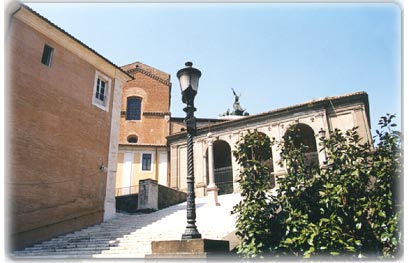 Venezia
and the monstrous Victor Emmanuel Monument (Italy's first king, apparently
his idea), an edifice viewed with disdain by most: "held to be the
epitome of self-important, insensitive architecture," says the guide
book. OK, so now that I've mentioned it, I guess I have to show
it ...
Venezia
and the monstrous Victor Emmanuel Monument (Italy's first king, apparently
his idea), an edifice viewed with disdain by most: "held to be the
epitome of self-important, insensitive architecture," says the guide
book. OK, so now that I've mentioned it, I guess I have to show
it ...
Getting to the truly beautiful places, we proceeded up the Cordonata — Michelangelo-designed steps, to the Piazza del Campidoglio with its Michelangelo-designed courtyard and building facades. (Was there anything this man was not great at?) Elegant buildings and sculptures under a bright blue sky. The Capitoline Museums flank the Piazza, and the Palazzo Senatorio, where Rome's city council gathers, is behind.
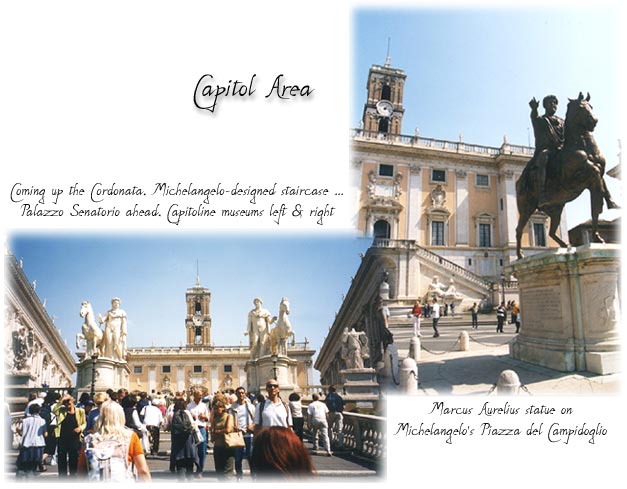
Just beyond was the
great Roman Forum, or the amazing ruins thereof. It was the focal point
of life ![]() in
ancient Rome, from commerce to politics to worship. Its excavation began
in the 18th century and is still ongoing ... the temples, arches, basilicas,
and columns date from many different periods. The Temples of Saturn and
Vespasian (picture below) and the well-preserved Arch of Emperor Septimius
Severus, built in 203 AD, are stunning. How is it that ruins look so glorious
in Italy? They withstand the ravages of time and retain an indefatigable
character. Probably has a lot to do with their origins … the pride and
quality they were erected with is still so evident. [Forum
panoramic]
in
ancient Rome, from commerce to politics to worship. Its excavation began
in the 18th century and is still ongoing ... the temples, arches, basilicas,
and columns date from many different periods. The Temples of Saturn and
Vespasian (picture below) and the well-preserved Arch of Emperor Septimius
Severus, built in 203 AD, are stunning. How is it that ruins look so glorious
in Italy? They withstand the ravages of time and retain an indefatigable
character. Probably has a lot to do with their origins … the pride and
quality they were erected with is still so evident. [Forum
panoramic]
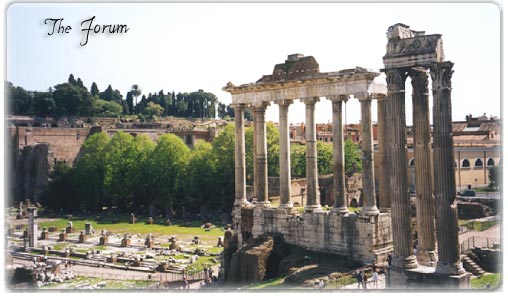
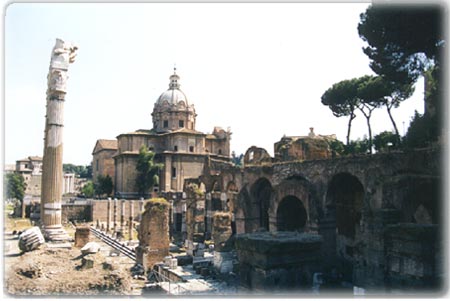 Then
the long walk down Via dei Fiori, a broad pedestrian road ... more Forum
ruins on one side and Trajan's Markets, a massive complex of shops and
offices built in the 2nd century AD, on the other. I'd never been on such
substantial ground, saturated with history.
Then
the long walk down Via dei Fiori, a broad pedestrian road ... more Forum
ruins on one side and Trajan's Markets, a massive complex of shops and
offices built in the 2nd century AD, on the other. I'd never been on such
substantial ground, saturated with history.
At first I felt it, then we saw it ... further ahead, the Colosseum.
![]() This
must be the most recognizable symbol of ancient Rome in the world ...
it was a thrill to finally see it ... and chilling to imagine the horrific
events (gladiator battles and wild animal fights) that took place inside.
The Colosseum (80 AD) has 80 arched entrances and could hold 55,000 spectators
— still a good size by today's standards. Hundreds of people were
lined up to buy tickets to get inside, so we passed on that, and satisfied
ourselves by walking its perimeter (on our own after the tour) and taking
it all in. We were in Rome.
This
must be the most recognizable symbol of ancient Rome in the world ...
it was a thrill to finally see it ... and chilling to imagine the horrific
events (gladiator battles and wild animal fights) that took place inside.
The Colosseum (80 AD) has 80 arched entrances and could hold 55,000 spectators
— still a good size by today's standards. Hundreds of people were
lined up to buy tickets to get inside, so we passed on that, and satisfied
ourselves by walking its perimeter (on our own after the tour) and taking
it all in. We were in Rome.
There is another magnificent arch next to the Colosseum — the Arch of Constantine (315 AD) ... I was surprised to learn that many of its reliefs and carvings were taken from other monuments to compose it, to mark Constantine's victory over his co-emperor. Lots of power plays in ancient Rome; it must have been a fascinating time.
Our tour also took us to the Basilica of St. Paul's — part of the Vatican, but outside of its walls. This was an exact reproduction of the 386 AD basilica that was destroyed by fire in 1823. The cloister garden (1214) was spared and has the original ornate, inlaid columns. There were remains of the church, and tombstones from the Catacombs, in the arcade around the garden — it's a beautiful place.
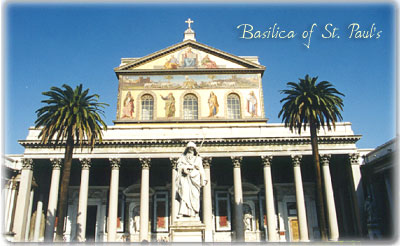 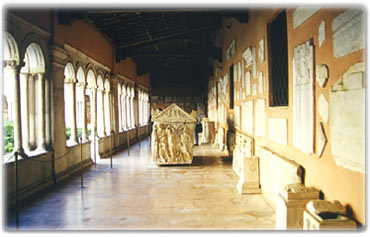 |
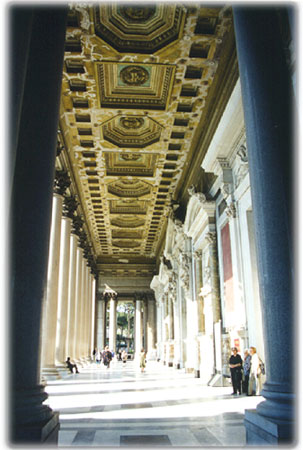 |
So, that's what we did on our first day ... a pretty whirlwind tour. Frankly, it was nowhere near enough time to do justice to these areas. But with only one more day in Rome, we had to get back to the Vatican ...
Back
to Italy main
Roma
• Roma2 • Roma3 • Vesuvio
& Pompei • Sorrento to Amalfi Coast
• Capri
Amalfi Coast • Perugia
• Siena & Toscana • Firenze
• Firenze2
© 2001 CCarnovale Home | Web Design | Graphics | Photos | Travels